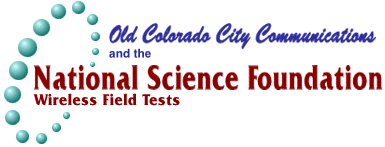
|
Voice 719.636.2040 · Fax 719.528.5869 ·Wireless Web http://wireless.oldcolo.com | ||
|
|
             |
Progress Report 6July 30th, 1996 With schools out for the summer, June and July were spent in contacting radio manufacturers to see if we could arrange tests of a wider range of radios, and visit educational sites where other wireless solutions were already installed and working, to evaluate them. As well as attending several conferences on networking. We also spent intense efforts, flowing from FCC requested visits to Washington, DC to provide input on the work the FCC is doing to implement the 1996 Telecommunications Act, which charges the FCC with developing plans for 'Universal Access' to networks by entities which cannot afford them at market rates - including an emphasis on schools and libraries. The 3d Annual 'Community Networking' conference was held in Taos, New Mexico the 14th to 16th of May. At that conference we presented a Wireless session, which included Jim Burger of Apple Corporation, and Mike Marcus, wireless engineer, from the FCC. It was a lively session, and Marcus learned what people in the field mean by 'community' networking, and why, particularly in rural areas, no-licence wireless is one of the only economical solutions to reaching ISPs from outlying communities. And Apple pressed the audience to support the Apple petition to the FCC for 'community wireless' rules for the 5Ghz band areas. During that trip to New Mexico, we made visits, with Carmen Gonzales of the University of New Mexico - a technology educator - to the Belen, New Mexico, School District. 30 miles south of Albuquerque. This district has installed a complete wireless network linking all 8 schools, and saving over $84,000 a year over a US West T-1 wired solution. I wrote a seperate report on the 'Wireless Success Story' which is posted on our NSF project web site (wireless.oldcolo.com, under Progress Reports) Meeting with FCC Commissioners The FCC held two 'roundtables' the 21st of May, 1996. Twelve representatives from education, telephone companies, technology firms, and a wireless company - Metricom - and I (representing this NSF Project), were invited to brainstorm with three of the FCC Commissioners (Reed Hundt, Susan Ness, Rachelle Chong) over 'Wireless and Education.' Dewayne Hendricks, representing his Warpspeed Imagineering company also was invited. It was organized by the Wireless Division of the FCC. It was held at the J.O. Wilson Elementary School inside the inner city of Washington DC, where the Cellular Telecommunications Industry Association (CTIA) had, using commercial cellular radios, sponsored some tests at the school. There were two sessions. I and Dewayne were invited to participate in both. Tom Kalil of the White House participated in the second session. The first was on 'Lessons Learned' and the second on 'Obstacles' (regulatory, economic, or whatever) The public (about 50 attended) was able to sit in the audience - largely from other agencies such as the Department of Education, and the National Science Foundation (6 attended) and observe. This was a head-turning meeting, because we seemed to be the only ones present representing real field projects involving both wireless and K-12 education. From the followup after the meeting, it was clear we had succeeded in putting 'no-licence wireless' seriously on the table to be considered in any plan attempting to give 'affordable access' to all public schools. There was a later, afternoon session, at the FCC offices, involving FCC staff, and the newly formed project organizations that had to deal with Universal Service fund aspects of Educational networking. That too was productive. We also met during this visit with six members of the NSF staff, out of which meetings came (1) the hard requirements for an NSF funded visit to Mongolia to network 8 sites to the Internet across Ulaana Bataar (2) what would be needed in an application for funds to undertake that project with part of our staff. And, a seperate initiative involving Dewayne Hendricks, and a potential funding of a developmental project by the Tuscon Amateur Packet Radio (TAPR) organization, to make prototype boards that could handle T-1 spread spectrum wireless speeds, at ranges from 10 to 200 kilometers, in radios costing under $500. The $1 million proposal to do that is underway as a grant request to the NSF. The remainder of June involved working on formal, FCC comments by this NSF Project on (1) antenna rules for Part 15 (2) Universal Service access by wireless and more intensly (3) Notice of Proposed Rule Making (NPRM) comments on the Apple/WINForum joint proposals for creating new rules for no-licence radio services in the 5Ghz range. The drafting and submission of these comments (all of which have been posted on this Web Site) in accordance with the formal rules for comment making, as well as studying the comments, both informal and formal made by the other 20 to 60 interested parties, was very time consuming. But also very important, for our comments, in effect, putting our findings-so-far to work, have been put to work influencing national public policy being made by the FCC.


|

